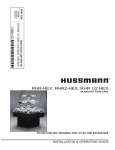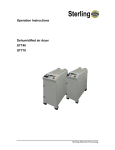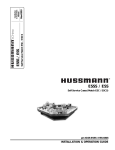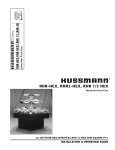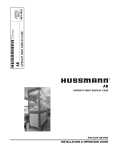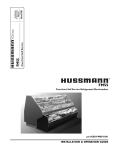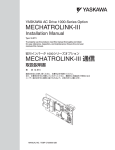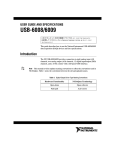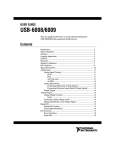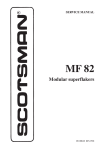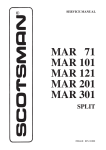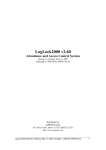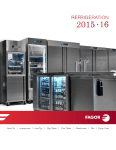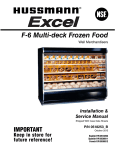Download hussman SCSS-SL User's Manual
Transcript
REV. 0108 Installation & Operation Manual SERVICE BAKERY SCSS / SCSS-SL /Chino SCSS / SCSS-SL SERVICE BAKERY P/N IGSSB-SCSS / SCSS-SL-0108 INSTALLATION & OPERATION GUIDE IGSSB-SCSS / SCSS-SL-0108 General Instructions Table of Contents THIS BOOKLET CONTAINS INFORMATION ON: MODEL DESCRIPTIONS All models are available in either 48”, 60” lengths. SCSSSL - Non-refrigerated Summit Cake Self-Service Bakery Case with 1, or 2 tier merchandising, and rear signage. SCSSSL - Refrigerated Summit Cake Self-Service Bakery Case with 1,or 2 tier merchandising, and rear signage. Remote unit requires separate condenser unit connection. Low Temperature Model (SCSSSL-RLL). SCSSSL -Self-contained refrigerated Summit Cake SelfService Bakery Case with 1, or 2 tier merchandising, and rear signage. Low Temperature Model (SCSSSL-S/CHL). APPLICATION These service-type merchandisers have been specifically designed for bakery departments.The front glass provides complete product visibility. The SCSSSL- non-refrigerated model, is designed to display fresh bakery products that have fast turnover and require no refrigeration. The SCSSSL- remote, and SCSSSL- self-contained, refrigerated baker y merchandisers are designed for use only in air conditioned stores where temperature and humidity are maintained at or below 75°F dry bulb temperature and 55% relative humidity. General Instructions ................................................. 2 Cut & Plan Views ....................................................... 4 Installation ................................................................. 5 LEVELING.............................................................................................................. 5 Plumbing .................................................................... 6 WASTE OUTLET AND P-TRAP .............................................................................. 6 JOINT TRIM ........................................................................................................... 6 Refrigeration ............................................................. 7 T-STAT LOCATION .................................................................................................. 8 Condensing Unit Installation Requirements ....................................................... 8 Electrical .................................................................... 9 WIRING COLOR CODE ......................................................................................... 9 ASHRAE COLOR CODE .......................................................................................... 9 User Information ...................................................... 12 STOCKING.............................................................................................................. 12 CASE CLEANING .................................................................................................... 12 NON-GLARE GLASS ............................................................................................... 13 PLEXIGLASS & ACRYLIC CARE .............................................................................. 13 Maintenance .............................................................. 14 ELECTRICAL PRECAUTIONS ................................................................................... 14 14 REPLACING FLUORESCENT LAMPS ....................................................................... 14 Electrical and Refrigeration Specifications ............ 14 TIPS & TROUBLESHOOTING ................................................................................. 14 Electrical Schematics ............................................... 15 Appendices ................................................................ 19 APPENDIX A. – Temperature Guidelines ............................................................ 19 APPENDIX B. – Application Recommendations .................................................. 19 APPENDIX C. – Field Recommendations - ......................................................... 19 APPENDIX D. – Recommendations to user - .................................................... 20 SHIPPING DAMAGE All equipment should be thoroughly examined for shipping damage before and during unloading. This equipment has been carefully inspected at our factory and the carrier has assumed responsibility for safe arrival. If damaged, either apparent or concealed, claim must be made to the carrier. APPARENT LOSS OR DAMAGE If there is an obvious loss or damage, it must be noted on the freight bill or express receipt and signed by the carrier’s agent; otherwise, carrier may refuse claim.The carrier will supply necessary claim forms. CONCEALED LOSS OR DAMAGE When loss or damage is not apparent until after equipment is uncrated, a claim for concealed damage is made. Make request in writing to carrier for inspection within 15 days, and retain all packaging. The carrier will supply inspection Keep this booklet with the case at all times for future reference. /Chino A publication of Hussmann® Chino 13770 Ramona Avenue • Chino, California 91710 (909) 628-8942 FAX (909) 590-4910 (800) 395-9229 2 Rev. 0108 report and required claim forms. SHORTAGES Check your shipment for any possible shortages of material. If a shortage should exist and is found to be the responsibility of Hussmann Chino, notify Hussmann Chino. If such a shortage involves the carrier, notify the carrier immediately, and request an inspection. Hussmann Chino will acknowledge shortages within ten days from receipt of equipment. HUSSMANN CHINO PRODUCT CONTROL The serial number and shipping date of all equipment has been recorded in Hussmann’s files for warranty and replacement part purposes. All correspondence pertaining to warranty or parts ordering must include the serial number of each piece of equipment involved, in order to provide the customer with the correct parts. The Hussmann warranty is printed on the back of this guide. 3 IGSSB-SCSS / SCSS-SL-0108 11 3/4" 44 1/2" 10" 35 / " (Remote Height) 40 3/4" (S/C Height) 30 1/2" Drain Location 12 1/2" 31 1/2" 17 1/2" 24 1/2" 9" 25 1/2" 15 1/4" 9 3/4" Refrig. Stub Up 1 4 12" 12 1/4" Elec. Stub Up (Med. Temp. Height) 15 3/4" 11 1/4" 2 3 / 4" 11 1/4" 2 3 / 4" (Remote Height) 21 1/4" 6 1/2" 35 1/2" 5 1/2" (Low Temp Ht) (S/C Height) Front Of Case 7 3/4" 48" (Variable) 44 1/2" SCSS SCSS Plan view Summit Cake Service Bakery Case (Remote & Self Contained) Scale = 1/2" 11 3/4" 6 1/2" Drain Location 9" 12 1/2" 31 1/2" Front Of Case 7 3/4" 38" 48" (Variable) SCSS-SL SCSS-SL Plan view Summit Cake Self-Service Bakery Case – Slim Line (Remote & Self Contained) Scale = 1/2" Scale = 1/2" 4 17 1/2" 30 1/2" 24 1/2" 38" Refrig. Stub Up Elec. Stub Up 3 1/2" 35 / " (Remote Height) 40 3/4" (S/C Height) 15 1/4" 9 3/4" 25 1/2" 14" 4 3/4" (Remote Height) 14 1/4" 35 1/2" 1 4 12" (Med. Temp. Height) 5 /" 1 2 (Low Temp Ht) 21 1/4" (S/C Height) 14 3/4" Scale = 1/2" 15 3/4" 14 3/4" Cut & Plan Views Rev. 0108 Installation LOCATION must be raised under leg or by use of 2x6 or 2x4 leg brace. Remove side and back leg braces after case is set. 3. Set second case as close as possible to the first case, and level case to the first using the instructions in step one. 4. Apply masking tape 1/8" in from end of case on inside and outside rear mullion on both cases to be joined. 5. Apply liberal bead of case joint sealant (butyl) to dotted area shown in (Fig.2, #1) of first case. Apply heavy amount to cover entire shaded area. DO NOT USE PERMAGUM! The refrigerated merchandisers have been designed for use only in air conditioned stores where temperature and humidity are maintained at or below 75°F and 55% relative humidity. DO NOT allow air conditioning, electric fans, ovens, open doors or windows (etc.) to create air currents around the merchandiser, as this will impair its correct operation. Product temperature should always be maintained at a constant and proper temperature. This means that from the time the product is received, through storage, preparation and display, the temperature of the product must be controlled to maximize life of the product. UNCRATING THE STAND Place the fixture as close to its permanent position as possible. Remove the top of the crate. Detach the walls from each other and remove from the skid. Unbolt the case from the skid. The fixture can now be lifted off the crate skid. Lift only at base of stand! It is the contractor’s responsibility to install case(s) according to local construction and health codes. EXTERIOR LOADING These models have not been structurally designed to support excessive external loading. Do not walk on their tops; This could cause serious personal injury and damage to the fixture. 6. Slide second case up to first case snugly.Then level second case to the first case so glass front, bumper and top are flush. 7. To compress butyl at joint, use two Jurgenson wood clamps. Make sure case is level from front to back and side to side on inside bulkheads at joint. 8. Attach sections together via a 2 bolts located in the base of the case. Secure the overhead structure by bolting the bracket, located inside behind lights. SETTING AND JOINING The sectional construction of these models enable them to be joined in line to give the effect of one continuous display. A joint trim kit is supplied with each joint LEVELING Important! It is imperative that cases be leveled from front to back and side to side prior to joining. A level case is necessary to insure proper operation, water drainage, glass alignment, and operation of the hinges supporting the glass. Leveling the case correctly will solve most hinge operation problems. Do not use cam locks to pull cases together. NOTE: A. To avoid removing concrete flooring, begin lineup leveling from the highest point of the store floor. B. When wedges are involved in a lineup, set them first. 9. Apply bead of butyl to top of bulkheads and slip on stainless steel bulkhead cap. Also apply butyl to seam between overhead light tubes. 10. VERY IMPORTANT! Apply liberal amounts of black butyl to area under interior lower legs and fill all voids down to bulkhead. 11.Use finger to smooth butyl as thin as possible at masking tape on inside and outside of rear mullion (apply additional butyl if necessary). Remove tape applied on line #3. All cases were leveled and joined prior to shipment to insure the closest possible fit when cases are joined in the field. When joining, use a carpenters level and shim legs accordingly. Case must be raised correctly, under legs where support is best, to prevent damage to case. 1. Check level of floor where cases are to be set. Determine the highest point of the floor; cases will be set off this point. 2. Set first case, and adjust legs over the highest part of the floor so that case is level. Prevent damage – case 5 IGSSB-SCSS / SCSS-SL-0108 Installation (cont’d.) JOINT TRIM After cases have been leveled and joined, and refrigeration, electrical, and wasted piping work completed, install the splashguards. Fasten along the top edge, or center, with #10 X 3/3" sheet metal screws. CORNER WEDGES Corner wedges are attached via front and rear camlocks. Use a 7mm Allen wrench to turn the locks. Do not overtighten! Join the top by using a joint bracket (included in joint kit) with 3/8" bolts. DO NOT SEAL JOINT TRIM TO FLOOR! Plumbing WASTE OUTLET AND P-TRAP The waste outlet is located off the center of the case on one side allowing drip piping to be run lengthwise under the fixture. A 3/4" P-trap and threaded adapter are supplied with each fixture.The P-trap must be installed to prevent air leakage and insect entrance into the fixture. 4. Avoid long runs of condensate drains. Long runs make it impossible to provide the “fall” necessary for good drainage. 5. Provide a suitable air break between the flood rim of the floor drain and outlet of condensate drain. 1" is ideal. 6. Prevent condensate drains from freezing: a. Do not install condensate drains in contact with non-insulated suction lines. Suction lines should be insulated with a nonabsorbent insulation material such as Armstrong’s Armaflex. b. Where condensate drains are located in dead air spaces (between refrigerators or between a refrigerator and a wall), provide means to prevent freezing.The water seal should be insulated to prevent condensation. NOTE: PVC-DWV solvent cement is recommended. Follow Hussmann’s instructions. INSTALLING CONDENSATE DRAIN Poorly or improperly installed condensate drains can seriously interfere with the operation of this refrigerator, and result in costly maintenance and product losses. Please follow the recommendations listed below when installing condensate drains to insure a proper installation: 1. Never use pipe for condensate drains smaller than the nominal diameter of the pipe or P-trap supplied with the case. 2. When connecting condensate drains, the P-trap must be used as part of the condensate drain to prevent air leakage or insect entrance. Store plumbing system floor drains should be at least 14" off the center of the case to allow use of the P-trap pipe section. Never use two water seals in series in any one line. Double P-traps in series will cause a lock and prevent draining. 3. Always provide as much down hill slope (“fall”) as possible; 1/8" per foot is the preferred minimum. PVC pipe, when used, must be supported to maintain the 1/8" pitch and to prevent warping. Waste Outlet Inside Case (All Models) Nipple Coupling 90° Air Gap 6 Remote Refrigeration Only! Rev. 0108 Refrigeration THERMOSTATIC EXPANSION VALVE LOCATION REFRIGERANT TYPE The standard refrigerant will be R-22 unless otherwise specified on the customer order. Check the serial plate on the case for information. This device is located on the same side as the refrigeration stub. A Sporlan balanced port expansion valve model is furnished as standard equipment, unless otherwise specified by customer. REFRIGERATION LINES LIQUID SUCTION 3/8" O.D. EXPANSION VALVE ADJUSTMENT Expansion valves must be adjusted to fully feed the evaporator. Before attempting any adjustments, make sure the evaporator is either clear or very lightly covered with frost, and that the fixture is within 10°F of its expected operating temperature. 5/8" O.D. NOTE: The standard coil is piped at 5/8" (suction); however, the store tie-in may vary depending on the number of coils and the draw the case has. Depending on the case setup, the connecting point in the store may be 5 /8", 7/8", or 11/8". Refer to the particular case you are hooking up. MEASURING THE OPERATING SUPERHEAT 1. Determine the suction pressure with an accurate pressure gauge at the evaporator outlet. 2. From a refrigerant pressure temperature chart, determine the saturation temperature at the observed suction pressure. 3. Measure the temperature of the suction gas at the thermostatic remote bulb location. 4. Subtract the saturation temperature obtained in step No. 2 from the temperature measured in step No. 3. 3. The difference is superheat. 5. Set the superheat for 5°F - 7°F. Multiplexing - Piping of merchandisers operating on the same refrigeration system may be run from merchandiser to merchandiser through the end frame saddles provided for this purpose. DO NOT RUN REFRIGERANT LINES THROUGH MERCHANDISERS THAT ARE NOT THE SAME REFRIGERATION SYSTEM as this may result in poor refrigeration control and compressor failure. Line Sizing - Refrigerant lines should be sized as shown on the refrigeration legend that is furnished for the store (not furnished by Hussmann). If a legend has not been furnished, refer to the Hussmann Application Engineering Manual for guidance. Oil Traps - P-traps (oil traps) must be installed at the base of all suction line vertical risers. Pressure Drop - Pressure drop can rob the system of capacity. To keep the pressure drop to a minimum, keep the refrigerant line run as short as possible using a minimum number of elbows. Where elbows are required, use long radius elbows only. Insulation - The suction and liquid lines should be clamped or taped together and insulated for a minimum of 30’ from the merchandiser. Additional insulation is recommended wherever condensation drippage is objectionable. Refrigerant lines should be sized as shown on the refrigeration legend furnished by the store. Install P-traps (oil traps) at the base of all suction line vertical risers. Pressure drop can rob the system of capacity. To keep the pressure drop to a minimum, keep refrigerant line run as short as possible, using the minimum number of elbows. Where elbows are required, use long radius elbows only. CONTROL SETTINGS See the “Case Specs” section of this guidebook for the appropriate settings for your merchandiser. Maintain these parameters to achieve near constant product temperatures. For all multiplexing, defrost should be time terminated. Defrost times should as directed in the Case Specifications section of this guide.The number of defrosts per day should never change.The duration of the defrost cycle may be adjusted to meet conditions present at your location. 0°F / -18°C or less air temperature.Adequate performance is assured by the desired condition of the product in case. ACCESS TO TX VALVES & DRAIN LINES MECHANICAL - Remove product from end of case. Remove product racks. Remove refrigeration and drain access panels (labeled). TX valve (mechanical only) and drain are located under each access panel at end of the case. ELECTRONIC - The Electronic Expansion valve master and slave cylinder(s) are located within the electrical access panel(s). ELECTRONIC EXPANSION VALVE (OPTIONAL) A wide variety of electronic expansion valves and case controllers can be utilized. Please refer to EEV and controller manufacturers information sheet. Sensors for electronic expansion valves will be installed on the coil inlet, coil outlet, and in the discharge air. (Some supermarkets require a 4th sensor in the return air). Case controllers will be located in the electrical raceway or under the case 7 IGSSB-SCSS / SCSS-SL-0108 PIPING T-STAT LOCATION T-Stats are located within the electrical raceway. For merchandisers with “electric” defrost, the suction and liquid lines should be clamped or taped together and insulated for a minimum of 30 feet. For models with “KOOLGAS®” defrost, suction, and liquid lines should not contact each other, and should be insulated separately for a minimum of 30 feet.With either type defrost, additional insulation for the balance of the liquid and suction lines is required wherever condensation and drippage would be objectionable. The refrigerant line outlets are located under the fixture at the left end when viewed from the back. Insulate suction lines to prevent condensation dripping on the floor. Condensing Unit Installation Requirements For proper operation of the Condensing Unit provide an opening with adequate exhause and intake as follows: Up to 1 1/2 hp: minimum of 2 vents totalling 150 sq. in. Over 1/2 hp: minimum of 2 vents totalling 150 sq. in. Self-Contained Model Installation - Low temperature merchandisers need to be connected to both a 120V / 60 Hz and 230V / 60 Hz electrical supply. 8 Rev. 0108 WIRING COLOR CODE GREEN PURPLE ORANGE YELLOW RED / BLACK BLACK / WHITE BROWN Electrical WIRING & SERIAL PLATE AMPERAGE Field Wiring must be sized for component amperes stamped on the serial plate. Actual ampere draw may be less than specified. Field wiring from the refrigeration con trol panel to the merchandisers is required for refrigeration thermostats. Most component amperes are listed in the "Case Specs" section, but always check the serial plate. GROUND ANTI-SWEAT LIGHTS RECEPTACLE T-STAT /SOLENOID230V T-STAT / SOLENOID 115V FAN MOTORS ASHRAE COLOR CODE NOTE: All other manufacturers; no known sensor codes CASE MUST BE GROUNDED NOTE: Refer to label affixed to case to determine the actual configuration as checked in the “TYPE INSTALLED” boxes. Case Control Systems SENSOR COLORS Manufacturer ® > EIL CPC ELECTRICAL CIRCUIT IDENTIFICATION Location Standard lighting for all models will be full length fluorescent lamps located within the case at the top. The switch controlling the lights, the plug provided for digital scale, and the thermometer are located at the rear of the case mullion. Coil Inlet Color Blue Blue Part# 225-01-1755225-01-3255 Color Red Part# 225-01-1757225-01-3123 Color Green Part# 225-01-1756225-01-3260 Color Purple Part# 225-01-1758225-01-3260 Color White Part# 225-01-0650225-01-3254 Color White Part# 225-01-0650225-01-3255 Coil Outlet Discharge Air ELECTRICAL SERVICE RECEPTACLES (WHEN APPLICABLE) Return Air The receptacle that is provided on the exterior back of these models is intended for computerized scales with a fifteen amp maximum load, not for large motors or other high wattage appliances. It should be wired to a dedicated circuit. Defrost Term. Liquid Line Red Green Green Orange Blue REAR CLOSE-OFF PANEL To perform electrical and refrigeration work, remove the rear closure panel by loosening the sheet metal screws. Replace when work is complete. ELECTRICAL Connections - All wiring must be in compliance with NEC and local codes. All electrical connections for the nonrefrigerated model are to be made in the electrical panel. Electrical connections for refrigerated models are made in the electrical box on the back of the case behind the rear close-off panel. Field Wiring - Field wiring must be sized for components amperes stamped on the serial plate. Actual ampere draw may be less than specified. Always check the serial plate. Post Construction Clean-up - After the first two weeks of a major store remodel or new store operation, the grill should be removed and the condensing unit and condenser face cleaned due to the accumulated dirt and debris generated during construction. BEFORE SERVICING ALWAYS DISCONNECT ELECTRICAL POWER AT THE MAIN DISCONNECT WHEN SERVICING OR REPLACING ANY ELECTRICAL COMPONENT. This includes (but not limited to) Fans, Heaters, Thermostats, and Lights. FIELD WIRING & SERIAL PLATE AMPERAGE Field Wiring must be sized for component amperes printed on the serial plate.Actual ampere draw may be less than specified. Field wiring from the refrigeration control panel to the merchandisers is required for refrigeration thermostats. Most component amperes are listed in the “Case Specs” section, but always check the serial plate. BALLAST LOCATION Ballasts are located within the access panel that runs the length of the rear of the case. 9 IGSSB-SCSS / SCSS-SL-0108 EKC 201 CONTROLLERS EKC 201 = 0 → +55°C troom tsystem = –60 → +50°C 12 V a.c./230 V a.c. 2.5 VA IP 54 Identification (See figs 1 and 2). 1. Light emitting diode = refrigeration = defrost = fan running 2. Minus sign 3. Display (Flashes when setting value for room temp. is displayed). 4. Keys for programming and setting (see programming instructions). Fig. 1 Programming and setting see programming instructions, parameter code, and settings. Press upper key for 2 s. Press lower key for 2 s. Press both keys at the same time. Quick guide What to do Initial controller Read or change room temp. Normal operation Read or change parameter codes and Re-establish all factory Read defrost sensor Manually start of a defrost Room Operating the two pushbuttons Set value Room temp. Normal operation (or alarm) Unknown codes Unknown settings Normal operation or alarm Resulting controller Display readout Change Normal operation Room temp. Room Normal operation (or alarm) Set value Code Room temp. Change Room temp. Power off Room temp. Room temp. Change Room temp. Power on Room temp. Defrost sensor temp. Room temp. Normal operation Room temp. Normal operation Known codes All parameter settings = factory Defrost operation Normal operation Room temp. Room temp. Manually stop of a defrost Reset alarm relay Defrost operation Room temp. Room temp. Room temp. Alarm relay Room temp. Alarm code/ Fault code Room temp. Room temp. Alarm code/ Fault code Room temp. Read codes Alarm relay not cause of alarm mode activated 10 Normal operation Alarm relay not Alarm Rev. 0108 Controller application setting parameters Setting and read-off parameters Parameter codes 1 Controller application no. 2 3 Min. value Max. value -60oC 50oC Factory setting Actual setting 4 Temperature controller, Temperature 3o C Thermostat Differential1) r01 0.1 K 20 K 2K Max. limitation of set temperature r02 -59oC 50oC 50oC Min. limitation of set temperature r03 -60oC 49oC -60oC Adjustment of temperature indication r04 -20 K 20 K 0.0 K Temperature unit (°C/°F) r05 o C Alarm Upper deviation (above temp. setting + differential 2) A01 0K 50 K 5K Lower deviation (below temp. setting 2) A02 0K 50 K 5K Temperature alarm delay A03 0 min 90 min 30 min Door alarm delay A04 0 min 60 min 30 min Compressor Min. ON-time c01 0 min 15 min 0 min Min. OFF-time c02 0 min 15 min 0 min Cut-in frequency on sensor fault 3) c03 0% 100 % 0% 0oC 25oC 6o C Defrost Defrost method (EL/GAS) d01 Defrost stop temperature d02 EL Interval between defrost starts d03 OFF 48 hour 8 hour Max. defrost duration d04 0 min 180 min 45 min Time staggening on defrost cut-ins at start-up d05 0 min 60 min 0 min Drip-off time d06 0 min 20 min 0 min Fan start delay after defrost d07 0 min 20 min 0 min Fan start temperature d08 -15oC 0 oC -5oC Fan cut-in during defrost (yes/no) d09 Defrost sensor (yes/no) d10 Temperature alarm delay after defrost d11 yes yes 0 min 199 min 90 min Fan Fan stop on compressor cut-out (yes/no) F01 Fan stop delay F02 0 min 15 min 0 min no Delay of output signal cancellation after start-up o01 2s 120 s 2s Digital input signals 4) (0 = not used, 1 = door alarm, 2 = defrost, 3 = bus) o02 Miscellaneous 0 Real time clock (if fitted) Six start times for defrost 0 23 OFF Hour setting t07 0 hour 23 hour 0 hour Minute setting t08 0 min 59 min 0 min All can be cut out by setting on OFF t01→ t06 Fault code display Alarm code display Fault in controller E1 High temperature alarm Disconnected room sensor E2 Low temperature alarm A2 Short-circuited room sensor E3 Door alarm A4 Disconnected defrost sensor E4 Status code display Short-circuited defrost sensor E5 ON-time ) The compressor relay closes when the room temperature exceeds the setting value and differential. ) Alarm is released and sensor failure is indicated, if the room temperature reaches 5°C or more outside the setting range –60° to +50°C. 3) The frequency is measured after approx. three days and nights operation after start of the plant (72 cyclings) otherwise: ON-time = c03 × 20: 100 minutes S2 OFF-time S3 Drip-off time S4 1 2 A1 4 OFF-time interval 20 minus ON-time per minute ) Function possibilities with SPDT contact, connected to the terminals 3 and 4 are the following: Door alarm: If SPST is cut out, alarm signalling starts and the fan is stopped, cf. A04 or F02. Defrost: If SPST is cut in, defrost starts. (However, if d03 is not OFF, defrost will during contact break down start with the programmed time intervalles). Bus: With installed communication card, the position of the SPST contacts will be registered in the BUS system. 11 IGSSB-SCSS / SCSS-SL-0108 User Information STOCKING In order to maximize product life, maintain a constant and proper product temperature from the time the product is received through storage, preparation and display. Products should not be placed in merchandisers until all refrigeration controls have been adjusted and merchandisers are at proper operating temperature. Care should be taken to place the bakery trays all the way to the front of the shelf. This avoids blocking the rear refrigerated air discharge.The load limit decals are affixed to the interior of the merchandiser. Again, air discharge and return air flue must be unobstructed at all times to provide proper refrigeration. There is also a row of vents located at the base of the front glass, just above the front rub rail. These vents allow a gentle air flow across the front glass from the ambient fans that prevents any condensation on the glass. Do Not place any signs or other restrictive objects on the front of the merchandiser that will block these vents. Improper temperature and lighting will cause serious product loss. Discoloration, dehydration and spoilage can be controlled with proper use of the equipment and handling of product. Product temperature should always be maintained at a constant and proper temperature. This means that from the time the product is received, through storage, preparation and display, the temperature of the product must be controlled to maximize life of the product. Hussmann cases were not designed to “heat up” or “cool down” product—but rather to maintain an item’s proper temperature for maximum shelf life. To achieve the protection required always: 1. Minimize processing time to avoid damaging temperature rise to the product. Product should be at proper temperature. 2. Keep the air in and around the case area free of foreign gasses and fumes or food will rapidly deteriorate. 3. Maintain the display merchandisers temperature controls as outlined in the refrigerator section of this manual. 4. Do not place any product into these refrigerators until all controls have been adjusted and they are operating at the proper temperature.Allow merchandiser to operate a minimum of 6 hours before stocking with any product. 5. When stocking, never allow the product to extend beyond the recommended load limit. Air discharge and return air flue must be unobstructed at all times to provide proper refrig- eration. 6. There are vents located at the base of the front of the glass, just above the front rail.These vents supply a continuous, gentle flow of air across the front glass which inhibits condensation. Do not place any signs or other restrictive objects on the front of the refrigerator that will block these vents. 8. Avoid the use of supplemental flood or spot lighting. Display light intensity has been designed for maximum visibility and product life at the factory.The use of higher output fluorescent lamps (H.O. and V.H.O.), will shorten the shelf life of the product. IMPORTANT STEPS 1. Do not set temperature too cold, as this causes product dehydration. See case specifications section of this book for proper settings. 2. Temperature control should be by means of a T-Stat and Suction Stop Solenoid at each case. Do not use EPR valves, Liquid Line Solenoids or electronic control devices of any kind, as these allow temperature swings causing dehydration and excessive energy consumption. 3. Product should be worked and rotated on a regular basis, not to exceed a 4-hour period. CASE CLEANING Long life and satisfactory performance of any equipment are dependent upon the care given to it.To insure long life, proper sanitation and minimum maintenance costs, the refrigerator should be thoroughly cleaned frequently. It is essential to establish and regulate cleaning procedures.This will minimize bacteria causing discoloration which leads to degraded product appearance and significantly shortening product shelf life. SHUT OFF FAN DURING CLEANING PROCESS. It can be unplugged within the case, or shut off case at the source. The interior bottom may be cleaned with any domestic soap or detergent based cleaners. The use of hoses and sage machines to clean the inside of the cases is recommended and is an excellent way to clean the coil fins and hard to reach corners of the interior of the cases. Be sure to observe the warnings below when cleaning the case. Sanitizing solutions will not harm the interior bottom, however, these solutions should always be used according to Hussmann’s directions and should not contain Ammonia. Soap and hot water are not enough to kill this bacteria. A sanitizing solution must be included with each cleaning process to eliminate this bacteria. 1. Allow cases to come to room temperature 12 Rev. 0108 User Information, Cont’d 2. Scrub thoroughly, cleaning all surfaces, with soap and hot water. 3. Rinse with hot water, but do not flood. 4. Apply the sanitizing solution according to Hussmann’s directions. 5. Rinse thoroughly. 6. Dry completely before resuming operation. Windex® or Glass Plus® are the only solutions recommended to be used to clean the non-glare glass. The damage to the glass from improper, caustic solutions is irreparable. In addition to cleaning the glass with the recommended product, there are precautions that should be taken when working and cleaning the inside of the case. • When cleaning the inside of the cases, we recommend that the glass be fully opened and covered to prevent solutions from splashing onto the glass and ruining the coating on the inside. PLEXIGLASS & ACRYLIC CARE Improper cleaning not only accelerates the cleaning cycle but also degrades the quality of this surface. Normal daily buffing motions can generated static cling attracting dust to the surface. Incorrect cleaning agents or cleaning cloths can cause micro scratching of the surface, causing the plastic to haze over time. CLEANING PRECAUTIONS WHEN CLEANING: • DO NOT WATER OVER 140° F • DO NOT INTRODUCE WATER FASTER THAN WASTE OUTLET CAN DRAIN • NEVER ON A SELF CONTAINED UNIT WITH AN EVAPORATOR FAN • NEVER USE A CLEANING OR SANITIZING SOLUTION THAT HAS AN OIL BASE (these will dissolve the butyl sealants) or an AMMONIA BASE (this will corrode the copper components of the case) TO PRESERVE THE ATTRACTIVE FINISH: • DO USE WATER AND A MILD DETERGENT FOR THE EXTERIOR ONLY • DO NOT USE ABRASIVES OR STEEL WOOL SCOURING PADS (these will mar the finish) CLEANING Hussmann recommends using a clean damp chamois, , or a paper towel marked as dust and abrasive free with 210® Plastic Cleaner and Polish available by calling Sumner Labs at 1-800-542-8656. Hard, rough cloths or paper towels will scratch the acrylic and should not be used. ANTISTATIC COATINGS NOTE: SELF-CONTAINED MODELS The 210® has proven to be very effective in not only cleaning and polishing the Plexiglass surface, but also providing anti-static and anti-fog capabilities. This product also seals pores and provides a protective coating. The evaporator pan must be monitored for overflow conditions. Provide drainage if necessary.After cleaning and rinsing, purge the pan of any standing water. • Care should be taken to minimize direct contact between fan motors and cleaning or rinse water. • Allow the merchandisers to dry before resuming operation. • When cleaning lighted shelves, wipe down with a damp sponge or cloth so that water does not enter the light channel. Do NOT use a hose or submerge shelves in water. CLEANING GLASS & MIRRORS Only use a soft cloth and mild glass cleaner for cleaning any glass or mirrored components. Be sure to rinse and/ or dry completely. Never use hot water on cold glass surfaces! It may shatter and cause serious injury! Allow glass surfaces to warm first. NON-GLARE GLASS The high optical clarity of this glass is possible due to special coatings on the glass surface itself. To preserve this coating and the optical clarity, keep the glass clean. 13 IGSSB-SCSS / SCSS-SL-0108 Maintenance COPPER COILS ELECTRICAL PRECAUTIONS The copper coils used in Hussmann merchandisers may be repaired in the field. Materials are available from local refrigeration wholesalers. Hussmann recommends using #15 Sil-Fos for repairs. BEFORE SERVICING – Always disconnect electrical power at the main disconnect when servicing or replacing any electrical component This includes (but not limited to) Fans, Heaters, Thermostats, and Lights. TIPS & TROUBLESHOOTING Before calling for service, check the following: 1. Check electrical power supply to the equipment for connection. 2. Check fixture loading. Overstocking case will affect its proper operation. 3. If frost is collecting on fixture and/or product, check that Humidity Control is working properly, and that no outside doors or windows are open—allowing moisture to enter store. REPLACING FLUORESCENT LAMPS Fluorescent lamps are furnished with a shatterproof protective coating. The same type of lamp with protective coating must be used if replaced. This lamp has been treated to resist breakage and must be replaced with a similarly treated lamp in order to maintain compliance with NSF Standards. NSF CODE 4.28.1 Contact HUSSMANN Chino for replacement 1-800-395-9229 x 2131 T-5 BULBS Please note:T-5 lights must be turned off and on after bulb replacement. FOR PROMPT SERVICE When contacting the factory, be sure to have the Case Model and Serial Number handy. This information is on a plate located on the case itself. EVAPORATOR FANS The evaporator fans are located at the center front of these merchandisers directly beneath the display pans. Should fans or blades need servicing, always replace fan blades with the raised embossed side of the blade TOWARD THE MOTOR. Electrical and Refrigeration Specifications Model & Length Refrigeration Btu / Hr. (Ft.) (Total) Average Temperatures (°F) Evap. Prod. Disch. Disch. Air Speed (CFM) T~Stat Settings (°F) Coil Type Size (in) & pitch ( ° ) Fan Blade Evap. Fans Motors Qty Defrosts Electrical Load (Amps) @ ~115 VAC per day Evap.Fans Case Case Defrost Length Qty Fans Warmer Lights Heater Glass Heater Condensing Unit Data Set (PSI) Size Voltage Out In (HP) Ampacity (VAC) SCSS-M Medium Temperature 4' 5' 6' 8' 650 650 650 650 2,600 3,250 3,900 5,200 20° 20° 20° 20° 40° 40° 40° 40° 30° 30° 30° 30° 200 200 200 200 Optional Optional Optional Optional Forced Air Forced Air Forced Air Forced Air 4" Axial 4" Axial 4" Axial 4" Axial 2 2 3 4 30 30 30 30 2 2 2 2 0.28 0.28 0.42 0.56 0.35 0.43 0.52 0.70 0.54 0.54 0.54 0.54 -25° -25° -25° -25° -10° -10° -10° -10° -20° -20° -20° -20° 200 200 200 200 Optional Optional Optional Optional Forced Air Forced Air Forced Air Forced Air 4" Axial 4" Axial 4" Axial 4" Axial 2 2 3 4 20 20 20 20 1 1 1 1 0.28 0.28 0.42 0.56 0.35 0.43 0.52 0.70 0.54 0.54 0.54 0.54 20° 20° 20° 20° 40° 40° 40° 40° 30° 30° 30° 30° 200 200 200 200 Optional Optional Optional Optional Forced Air Forced Air Forced Air Forced Air 4" Axial 4" Axial 4" Axial 4" Axial 2 2 3 4 30 30 30 30 2 2 2 2 0.28 0.28 0.42 0.56 0.35 0.43 0.52 0.70 0.54 0.54 0.54 0.54 -25° -25° -25° -25° -10° -10° -10° -10° -20° -20° -20° -20° 200 200 200 200 Optional Optional Optional Optional Forced Air Forced Air Forced Air Forced Air 4" Axial 4" Axial 4" Axial 4" Axial 2 2 3 4 20 20 20 20 1 1 1 1 0.28 0.28 0.42 0.56 0.35 0.43 0.52 0.70 0.54 0.54 0.54 0.54 SCSS-M Low Temperature 4' 5' 6' 8' 800 800 800 800 SCSS-SLM 4' 5' 6' 8' 540 540 540 540 3,200 4,000 4,800 6,400 5.77 9.62 9.62 10.82 0.42 0.52 0.63 0.63 30 30 30 30 50 50 50 50 30 30 30 30 50 50 50 50 30 30 30 30 50 50 50 50 30 30 30 30 50 50 50 50 1/2 115 13.6 3/4 115 18.5 3/4 115 18.5 1 208~230 11.8 1-1/2 1-1/2 1-1/2 2 208 208 208 208 14.7 14.7 14.7 12.8 Slim Line - Medium Temperature 2,160 2,700 3,240 4,320 1/2 115 13.6 3/4 115 18.5 3/4 115 18.5 1 208 ~ 23011.8 SCSS-SLLSlim Line - Low Temperature 4' 5' 6' 8' 625 625 625 625 2,500 3,125 3,750 5,000 14 5.77 9.62 9.62 10.82 0.42 0.52 0.63 0.63 1-1/2 1-1/2 1-1/2 2 208 208 208 208 14.7 14.7 14.7 12.8 15 Hussmann Corporation, Int'l. 13770 Ramona Avenue Chino, CA. 91710 (909)-590-4910 Lic.#: 644406 Glass Heater M Evaporator Fans M Anti-Sweat Heater Revisions: No. Description: M Temp Sensor M Date: By: Drawing No.: to Temp/Defrost Controller Project Title: Refrigerated Medium Temp Self-Service Desplay Drawing Title: ~115V H:\WiringSchematics\NewWiringDiagrams\ SCSS-M Remote, Off-Cycle Defrost Wiring Diagram Drawn By: Boris Kasrel Checked By: BJK Date: 00.00.00 Assembly: BOM... / Prod# File Location: ~115V-1Ph-60Hz-2.5A J- BOX Sheet 1 of 1 W8000001mnl Rev. 0108 Electrical Schematics 16 M M Evaporator Revisions: No. Description: controls lines Klixon 20420L15-013-302 L40-1.5 Q00VA 40ºF Hussmann Corporation, Int'l. 13770 Ramona Avenue Chino, CA. 91710 (909)-590-4910 Lic.#: 644406 Legend: M Temp Sensor Glass Htr 60W ~115V 20ºF Anti-Sweat Htr 85W ~115V M Date: Htr Shut-Off By: 12 black H:\WiringSchematics\In-Work\... Drawn By: Boris Kasrel Checked By: BJK Date: 03.29.01 Assembly: 495-01-... / 880... File Location: 12 orange 12 green SCSS-L-E, Remote, Electrical Defrost Wiring Diagram Project Title: Refrigerated Low Temp Self-Service Display Drawing Title: 12 white ~115V 12 orange Sheet 1 of 1 W8100001mnl. ~208/230V 12 black Drawing No.: to Temp/Defrost Controller 12 black (2) ~208/230V Finned Defrost Htr J-Box, SCSS-L--KG, Remote, Kool Gas Defrost IGSSB-SCSS / SCSS-SL-0108 17 40ºF M Hussmann Corporation, Int'l. 13770 Ramona Avenue Chino, CA. 91710 (909)-590-4910 Lic.#: 644406 Legend: M Evaporator Revisions: No. Description: controls lines Klixon 20420L15-013-302 L40-1.5 Q00VA M Temp Sensor Glass Htr 60W ~115V M Klixon #600-22-0010 20420l28-229-89 L20 - 1.5 R98A 20ºF Anti-Sweat Htr 85W ~115V Date: Htr Shut-Off Fans Shut-Off By: 12 black H:\WiringSchematics\In-Work\... Drawn By: Boris Kasrel Checked By: BJK Date: 03.28.01 Assembly: 495-01-... / 880... File Location: 12 orange 12 green SCSS-L-KG, Remote, Kool Gas Defrost Wiring Diagram Project Title: Refrigerated Low Temp Self-Service Display Drawing Title: 12 white ~115V 12 orange Sheet 1 of 1 W8100002mnl. ~208/230V 12 black Drawing No.: to Temp/Defrost Controller 12 black ~208/230V Finned Defrost Htr J-Box, SCSS-L--KG, Remote, Kool Gas Defrost Rev. 0108 18 M M Revisions: No. Description: Temp Probe Hussmann Corporation, Int'l. 13770 Ramona Avenue Chino, CA. 91710 (909)-590-4910 Lic.#: 644406 M Evaporator Temp Probe Condensation Pan ~115V Glass Htr 60W ~115V Anti-Sweat Htr 85W ~115V ~208/230-1Ph Condensing Unit Legend: Evap Temp Defrost Termination M High/Low Pressure Safety (2) ~208/230V Finned Defrost Htr 12 black 12green Date: By: controls lines 12green 12 white 12 black 12green 12 white 12 black 12 black 12 black 12 black 12 orange 12 orange 2 3 ~115V 4 H:\WiringSchematics\In-Work\... 6 7 12 black 12 orange Compressor ~208/230V 12 black-hot 8 15 9 11 10 3 5 7 Transformer SCSS-L-E-S/C, Self-Contained, Electrical Defrost Wiring Diagram Drawing No.: 2 4 6 17 16 EKC 201 ~12V 13 12 14 Project Title: Refrigerated Low Temp Self-Service Display Drawing Title: 12 black 12 white 12 green 5 Drawn By: Boris Kasrel Checked By: BJK Date: 03.30.01 Assembly: 495-01-... / 880... File Location: 1 12 black ~115V 12 white 12 black Heaters 12 orange J-Box, SCSS-L-E-S/C, Low Temp, Self-Contained, ElectricalDefrost Sheet 1 of 1 W8100003mnl. ~12V IGSSB-SCSS / SCSS-SL-0108 Rev. 0108 Appendices dations are included in the standard. They are based on confirmed field experience over many years. 1.1 The installer is responsible for following the installation instructions and recommendations provided by Hussmann for the installation of each individual type refrigerator. 1.2 Refrigeration piping should be sized according to the equipment manufacturer’s recommendations and installed in accordance with normal refrigeration practices. Refrigeration piping should be insulated according to Hussmann’s recommendations. 1.3 A clogged waste outlet blocks refrigeration. The installer is responsible for the proper installation of the system which dispenses condensate waste through an air gap into the building indirect waste system. 1.4 The installer should perform a complete start-up evaluation prior to the loading of food into the refrigerator, which includes such items as: a) Initial temperature performance, Coils should be properly fed with a refrigerant according to manufacturer’s recommendations. b) Observation of outside influences such as drafts, radiant heating from the ceiling and from lamps. Such influence should be properly corrected or compensated for. c) At the same time, checks should be made of the store dry-bulb and wet-bulb temperatures to ascertain that they are within the limits prescribed by Hussmann. d) Complete start-up procedures should include checking through a defrost to make certain of its adequate frequency and length without substantially exceeding the actual needs. This should include checking the electrical or refrigerant circuits to make sure that defrosts are correctly programmed for all the refrigerators connected to each refrigeration system. e) Recording instruments should be used to check performance. APPENDIX A. – TEMPERATURE GUIDELINES REFRIGERATED The refrigerators should be operated according to Hussmann’s published engineering specifications for entering air temperatures for specific equipment applications. Table 1 shows the typical temperature of the air entering the food zone one hour before the start of defrost and one hour after defrost for various categories of refrigerators. Refer to Appendix C for Field Evaluation Guidelines. TABLE 1 TYPE OF REFRIGERATOR TYPICAL ENTERING AIR TEMPERATURE I. OPEN DISPLAY A. Non frozen: 1) Meat 2) Dairy/Deli 3) Produce a. Processed b. Unprocessed B. Frozen C. Ice Cream II. CLOSED DISPLAY A. Non frozen: 1) Meat 2) Dairy/Deli 3) Produce a. Processed b. Unprocessed B. Frozen C. Ice Cream 28°F 32°F 36°F 45°F 0°F -5°F 34°F 34°F 36°F 45°F 0°F -5°F APPENDIX C. – FIELD RECOMMENDATIONS REFRIGERATED Recommendations for field evaluating the performance of retail food refrigerators and hot cases Single Deck Multi Deck I. Open Display Styles Service Case Reach-In 1.0 The most consistent indicator of display refrigerator performance is temperature of the air entering the product zone (Refrigerated see Diagram 1, Appendix A). In practical use, the precise determination of return air temperature is extremely difficult. Readings of return air temperatures will be variable and results will be inconsistent. The product temperature alone is not an indicator of refrigerator performance. II. Closed Display Styles APPENDIX B. – APPLICATION RECOMMENDATIONS REFRIGERATED 1.0 Temperature performance is critical for controlling bacteria growth. Therefore, the following recommen- NOTE: Public Health will use the temperature of the product in determining if the refrigerator will be allowed to display potentially hazardous food. For the purpose of 19 IGSSB-SCSS / SCSS-SL-0108 Appendices, Cont’d 8. this evaluation, product temperature above the FDA 9. Food Code 1993 temperature for potentially hazardous 10. food will be the first indication that an evaluation should 11. be performed. It is expected that all refrigerators will keep food at the FDA Food Code 1993 temperature for potentially hazardous food. Is there exposure to direct sunlight? Are display signs blocking or diverting airflow? Are the coils of the refrigerator iced up? Is the store ambient over 75°F, 55% RH as set forth in ASHRAE Standard 72 and ASHRAE Standard 117? 12. Are the shelf positions, number, and size other than recommended by Hussmann? 13. Is there an improper application or control system? 14. Is the evaporator fan motor/blade inoperative? 15. Is the defrost time excessive? 16. Is the defrost termination, thermostat (if used) set too high? 17. Are the refrigerant controls incorrectly adjusted? 18. Is the air entering the condenser above design conditions? Are the condenser fins clear of dirt, dust, etc.? 19. Is there a shortage of refrigerant? c) READING – The thermometer reading should be made only after it has been allowed to stabilize, i.e., maintain a constant reading. Loading Product: Cases should be allowed to heat up for one hour before product is loaded. Temperature adjustments: Allow 4 hours after adjustment has been made before testing pulp temperature of product. d) OTHER OBSERVATIONS – Other observations should be made which may indicate operating problems, such as unsatisfactory product, feel/ appearance. 1.1 The following recommendations are made for the purpose of arriving at easily taken and understood data which, coupled with other observations, may be used to determined whether a display refrigerator is working as intended: a) INSTRUMENT – A stainless steel stem-type thermometer is recommended and it should have a dial a minimum of 1 inch internal diameter. A test thermometer scaled only in Celsius or dually scaled in Celsius and Fahrenheit shall be accurate to 1°C (1.8°F). Temperature measuring devices that are scaled only in Fahrenheit shall be accurate to 2°F. The thermometer should be checked for proper calibration. (It should read 32°F when the stem is immersed in an ice water bath). b) LOCATION – The probe or sensing element of the thermometer should be located in the airstream where the air first enters the display or storage area, and not more than 1 inch away from the surface and in the center of the discharge opening. c) READING – It should first be determined that the refrigerator is refrigerating and has operated at least one hour since the end of the last defrost period. The thermometer reading should be made only after it has been allowed to stabilize, i.e., maintain a constant reading. d) OTHER OBSERVATIONS – Other observations should be made which may indicate operating problems, such as unsatisfactory product, feel/ appearance. e) CONCLUSIONS – In the absence of any apparent undesirable conditions, the refrigerator should be judged to be operating properly. If it is determined that such condition is undesirable, i.e., the product is above proper temperature, checks should be made for the following: 1. Has the refrigerator been loaded with warm product? 2. Is the product loaded beyond the “Safe Load Line” markers? 3. Are the return air ducts blocked? 4. Are the entering air ducts blocked? 5. Is a dumped display causing turbulent air flow and mixing with room air? 6. Are spotlights or other high intensity lighting directed onto the product? 7. Are there unusual draft conditions (from heating /air-conditioning ducts, open doors, etc.)? APPENDIX D. – RECOMMENDATIONS TO USER REFRIGERATED 1.0 Hussmann should provide instructions and recommendations for proper periodic cleaning. The user will be responsible for such cleaning, including the cleaning of low temperature equipment within the compartment and the cooling coil area(s). Cleaning practices, particularly with respect to proper refrigerator unloading and warm-up, must be in accordance with applicable recommendations. 1.1 Cleaning of non frozen food equipment should include a weekly cleaning of the food compartment as a minimum to prevent bacteria growth from accumulating. Actual use and products may dictate more frequent cleaning. Circumstances of use and equipment design must also dictate the frequency of cleaning the display areas. Weekly washing down of the storage compartment is also recommended, especially for equipment subject to drippage of milk or other liquids, or the collection of vegetable, meat, crumbs, etc. or other debris or litter. Daily cleaning of the external areas surrounding the storage or display compart- 20 Rev. 0108 Appendices, Cont’d ments with detergent and water will keep the equipment presentable and prevent grime buildup. 1.2 Load levels as defined by Hussmann must be observed. 1.3 The best preservation is achieved by following these rules: a) Buy quality products. b) Receive perishables from transit equipment at the ideal temperature for the particular product. c) Expedite perishables to the store’s storage equipment to avoid unnecessary warm-up and prolonged temperature recovery. Food store refrigerators are not food chillers nor can they reclaim quality lost through previous mishandling. d) Care must be taken when cross merchandising products to ensure that potentially hazardous vegetable products are not placed in non refrigerated areas. e) Display and storage equipment doors should be kept closed during periods of inactivity. f) Minimize the transfer time of perishables from storage to display. g) Keep meat under refrigeration in meat cutting and processing area except for the few moments it is being handled in processing. When a cut or tray of meat is not to be worked on immediately, the procedure should call for returning it to refrigeration. h) Keep tools clean and sanitized. Since mechanical equipment is used for fresh meat processing, all such equipment should be cleaned at least daily and each time a different kind of meat product comes in contact with the tool or equipment. i) Make sure that all refrigeration equipment is installed and adjusted in strict accordance with Hussmann’s recommendations. j) See that all storage and refrigeration equipment is kept in proper working order by routine maintenance. 21 IGSSB-SCSS / SCSS-SL-0108 22 Rev. 0108 Limited Warranty This warranty is made to the original user at the original installation site and is not transferable. Hussmann merchandisers are warranted to be free from defect in material and workmanship under normal use and service for a period of one (1) year from the date of original installation (not to exceed fifteen (15) months from the date of shipment for the factory). Hussmann Impact Modular Coils are warranted for a total of five (5) years based upon the above criteria. Hussmann’s obligation under this warranty shall be limited to repairing or exchanging any part or parts, without charge F.O.B. factory or nearest authorized parts depot within said period and which is proven to the satisfaction of the original manufacturing plant warranty group to be thus defective. Hussmann covers the entire case or refrigeration product and all its components (except for lamps, driers, fuses, and other maintenance type replacement parts) for the one (1) year warranty period. Additionally, Hussmann warrants for a total period of three (3) years all sealed, multi-glass assemblies except those used in sliding doors on closed meat display cases. If within three (3) years from the date of installation (not to exceed thirtynine (39) months from the date of shipment from factory), it shall be proven to the satisfaction of the originating factory warranty group that there is impaired visibility through the multi-glass assemblies thereof caused by moisture between the glasses, the multi-glass assembly will be replaced free of charge, F.O.B. factory. This additional warranty excludes accident, misuse, or glass breakage. On Hussmann manufactured self-contained display cases, Hussmann agrees to repair or exchange, at its option, the original motor/compressor unit only with a motor/compressor of like or of similar design and capacity if it is shown to the satisfaction of Hussmann that the motor/compressor is inoperative due to defects in factory workmanship or material under normal use and service as outlined in Hussmann’s “Installation Instructions” which are shipped inside new Hussmann equipment. Hussmann’s sole obligation under this warranty shall be limited to a period not to exceed five years from date of factory shipment. On Hussmann refrigeration systems, an additional (4) year extended warranty for the motor/compressor assembly is available, but must be purchased prior to shipment to be in effect. Hussmann reserves the right to inspect the job site, installation and reason for failure. The motor/compressor warranties listed above do not include replacement or repair of controls, relays, capacitors, overload protectors, valve plates, oil pumps, gaskets or any external part on the motor/compressor replaceable in the field, or any other part of the refrigeration system or self-contained display case. THE WARRANTIES TO REPAIR OR REPLACE ABOVE RECITED ARE THE ONLY WARRANTIES, EXPRESS, IMPLIED OR STATUTORY, MADE BY HUSSMANN WITH RESPECT TO THE ABOVE MENTIONED EQUIPMENT, INCLUDING ANY IMPLIED WARRANTY OF MERCHANTABILITY OR FITNESS, AND HUSSMANN NEITHER ASSUMES NOR AUTHORIZES ANY PERSON TO ASSUME FOR IT, ANY OTHER OBLIGATION OR LIABILITY IN CONNECTION WITH THE SALE OF SAID EQUIPMENT OR ANY PART THEREOF. THIS WARRANTY SHALL NOT APPLY TO LOSS OF FOOD OR CONTENTS OF THE EQUIPMENT DUE TO FAILURE FOR ANY REASON. HUSSMANN SHALL NOT BE LIABLE: • For payment of labor for any removal or installation of warranted parts; • For any repair or replacements made without the written consent of Hussmann, or when the equipment is installed or operated in a manner contrary to the printed instructions covering installation and service which accompanied such equipment; • For any damages, delays, or losses, direct or consequential which may arise in connection with such equipment or part thereof; • For damages caused by fire, flood, strikes, acts of God or circumstances beyond its control; • When the equipment is subject to negligence, abuse, misuse or when the serial number of the equipment has been removed, defaced, or altered; • When the equipment is operated on low or improper voltages • When the equipment is put to a use other than normally recommended by Hussmann (i.e. deli case used for fresh meat); • When operation of this equipment is impaired due to improper drain installation; • For payment of refrigerant loss for any reason; • For costs related to shipping or handling of replacement parts. Hussmann Corporation, Corporate Headquarters: Bridgeton, Missouri, U.S.A. 63044 August 1, 1998 23 IGSSB-SCSS / SCSS-SL-0108 Service Record Last service date: By: /Chino The MODEL NAME and SERIAL NUMBER is required in order to provide you with the correct parts and information for your particular unit. Additional copies of this publication may be obtained by contacting: Hussmann® Chino 13770 Ramona Avenue • Chino, California 91710 (909) 628-8942 FAX (909) 590-4910 (800) 395-9229 They can be found on a small metal plate on the unit. Please note them below for future reference. MODEL: SERIAL NUMBER: 24
























